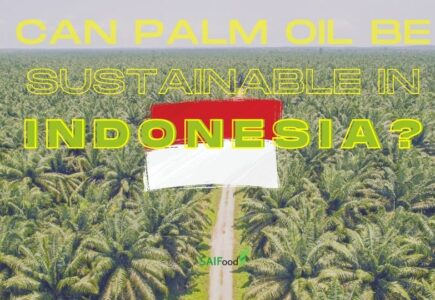Claire Owen
Agribusiness Undergraduate 2022
Can sustainable intensification alleviate agricultural production of oil palm in Indonesia?
Palm oil is in many of the products that we consume and use daily. If you have ever eaten chocolate or bread or bought shampoo or detergent, there is a high chance that palm oil was an ingredient in it1. It’s a widely used product as it is so versatile, and has a long shelf life2. The majority of the world’s supply comes from Indonesia, it is the largest oil palm producing country as it supplies 54% of global palm oil 3. As a result of oil palm production, Indonesia has significant tropical deforestation rates. Deforestation across the globe is contributing to climate change through greenhouse gas (GHG) emissions, loss of biodiversity and carbon sequestration.
Instead of continuing to convert forests into palm production, Indonesian oil palm producers could consider sustainable intensification (SI). Sustainable intensification is a strategy that increases crop production on land already cultivated with limited negative environmental impacts 4. There are many agricultural methods that could classify as SI including integrated pest management, crop variety improvements, conservation agriculture, agroforestry systems, patch intensification and sustainable rice intensification 5. In Indonesia, sustainable intensification is a feasible solution for oil palm production, however, some barriers may include lack of government support, accessibility to necessary resources, and uncertainty.
The importance of sustainable intensification in Indonesia
Indonesia is the largest producer of oil palm and is a significant driver of tropical deforestation in the country 3. Agricultural activity is the main driver of deforestation in Indonesia, and sustainable intensification has been a method brought forward to minimize the impact of deforestation 6. Sustainable intensification can reduce deforestation in Indonesia, however, there is much more required to reach its’ full potential. Indonesia has implemented successful and sustainable intensification strategies in other commodities on top of oil palm. This includes cocoa agroforestry, integrated pest management (IPM) and system of rice intensification (SRI) 7–10. The benefits of each ranged from economic, socio-economic, and environmental, generally, including an increase in output, food price reduction, improved pest control management, improved soil health, increased resource efficiency, and improved food security 5.
What is needed for sustainable intensification in Indonesia?
An essential aspect of sustainable intensification implementation is that farmers have the proper knowledge, technology, and resources to carry SI out 11. More farmer knowledge, labour, and capital are required, though the adoption of SI strategies can be limited due to several factors. This can include risk aversion, time constraints, limited technology and uncertainty. Failure of intensification in some regions has also arisen from labour constraints, as more work is required for intensification11. Farmers also require off-farm labour for their livelihood, which is a trend across many in Indonesia, and the younger generations are also looking for off-farm work11.
Numerous studies have shown that improved market access can enhance capital on all fronts, which is necessary for sustainable intensification. For example, Maryati et al. (2020) showed that improved agricultural roads can benefit farmers in Indonesia through many avenues, specifically time-saving, and a reduction in costs through lower transportation and transaction costs. Other essential factors for sustainable intensification include accessibility to credit, markets, and land titles. Access to formal land titles will enable farmers to intensify their land and invest more in their land in the long run 13. Land titles can also be used to receive financial credit so that farmers can further invest in their land 13. When there are no land titles, farmers at the edge of a forest are less able and willing to increase productivity and have a stronger incentive to increase farm size by expanding into forest land 13. It is also less expensive to expand a farm through deforestation, this is due to lower transportation costs that come with bad infrastructure, even if there are formal land titles 13.
Certification is important for Indonesian farmers, especially as demand for commodities such as palm oil increases 14. This is because consumers are willing to pay more for environmentally friendly products, and certification labels on products provide consumers with the information they seek, all while offering a premium to producers. Although it can be costly to obtain such certifications. There are also calls worldwide for ‘no deforestation oil palm, no exploitation’ which will incentivize oil palm plantations to adopt intensification strategies 15. Certification schemes for palm production can also help corporate and smallholder farmers adopt SI strategies and receive benefits to meet this increase in demand.
On top of certification schemes, successful sustainable intensification adoption will require government policy and support, and improvements in forest conservation, land-use decisions, subsidization, and improved infrastructure 16–18. For example, input markets and infrastructure can help Indonesian smallholder farmers adopt intensification strategies as it can lower the effective cost of inputs for farmers and raise effective output prices16.
Looking forward
Palm oil is an ingredient in many of the products that we consume and use on a daily basis, although it is also a significant driver of deforestation in Indonesia. Sustainable intensification has ‘caught momentum’ in scientific literature and popular media as a way to minimize the impact that agriculture has on deforestation. Forests supply water, and livelihoods, as well as mitigate climate change, and are essential for sustainable food production 19, which is why it’s important that we protect them. There is potential in Indonesia for more sustainable oil palm production strategies such as SI, though there are still obstacles that remain. These obstacles include a lack of resources, knowledge, and incentives among smallholder farmers. As a consumer, it can be important to be aware of the products that we consume and where they come from, and continue to evolve our knowledge on how we can support sustainable agricultural practices.
- WWF. (n.d.). Which Everyday Products Contain Palm Oil? WWF. Retrieved May 29, 2022, from https://www.worldwildlife.org/pages/which-everyday-products-contain-palm-oil
- WWF. (n.d.). 8 things to know about palm oil. WWF. Retrieved June 1, 2022, from https://www.wwf.org.uk/updates/8-things-know-about-palm-oil
- Jelsma, I., Woittiez, L. S., Ollivier, J., & Dharmawan, A. H. (2019). Do wealthy farmers implement better agricultural practices? An assessment of implementation of Good Agricultural Practices among different types of independent oil palm smallholders in Riau, Indonesia. Agricultural Systems, 170, 63–76. https://doi.org/10.1016/j.agsy.2018.11.004
- The Royal Society. (2009). Reaping the benefits science and the sustainable intensification of global agriculture. The Royal Society.
- Pretty, J., & Bharucha, Z. P. (2014). Sustainable intensification in agricultural systems. Annals of Botany, 114(8), 1571–1596. https://doi.org/10.1093/aob/mcu205
- FAO. (2020). The State of the World’s Forests 2020. FAO and UNEP. https://doi.org/10.4060/ca8642en
- Jelsma, I., Slingerland, M., Giller, K. E., & Bijman, J. (2017). Collective action in a smallholder oil palm production system in Indonesia: The key to sustainable and inclusive smallholder palm oil? Journal of Rural Studies, 54, 198–210. https://doi.org/10.1016/j.jrurstud.2017.06.005
- Nababan, F. E., & Regina, D. (2021). The challenges of integrated farming system development towards sustainable agriculture in Indonesia. E3S Web of Conferences, 306, 05015. https://doi.org/10.1051/e3sconf/202130605015
- Pretty, J., & Bharucha, Z. (2015). Integrated Pest Management for Sustainable Intensification of Agriculture in Asia and Africa. Insects, 6(1), 152–182. https://doi.org/10.3390/insects6010152
- Takahashi, K. (2013). The roles of risk and ambiguity in the adoption of the system of rice intensification (SRI): Evidence from Indonesia. Food Security, 5(4), 513–524. https://doi.org/10.1007/s12571-013-0270-z
- Purnawan, E., Brunori, G., & Prosperi, P. (2020). Small Family Farms; A Perspective from Indonesia, Challenges and Investment. https://doi.org/10.13140/RG.2.2.29704.03849
- Maryati, S., Firman, T., Siti Humaira, A. N., & Febriani, Y. T. (2020). Benefit Distribution of Community-Based Infrastructure: Agricultural Roads in Indonesia. Sustainability, 12(5), 2085. https://doi.org/10.3390/su12052085
- Kubitza, C., Krishna, V. V., Urban, K., Alamsyah, Z., & Qaim, M. (2018). Land Property Rights, Agricultural Intensification, and Deforestation in Indonesia. Ecological Economics, 147, 312–321. https://doi.org/10.1016/j.ecolecon.2018.01.021
- Andres, C., & Bhullar, G. S. (2016). Sustainable Intensification of Tropical Agro-Ecosystems: Need and Potentials. Frontiers in Environmental Science, 4. https://www.frontiersin.org/article/10.3389/fenvs.2016.00005
- Varkkey, H., Tyson, A., & Choiruzzad, S. A. B. (2018). Palm oil intensification and expansion in Indonesia and Malaysia: Environmental and socio-political factors influencing policy. Forest Policy and Economics, 92, 148–159. https://doi.org/10.1016/j.forpol.2018.05.002
- Byerlee, D., Stevenson, J., & Villoria, N. (2014). Does intensification slow crop land expansion or encourage deforestation? Global Food Security, 3(2), 92–98. https://doi.org/10.1016/j.gfs.2014.04.001
- Harahap, F., Silveira, S., & Khatiwada, D. (2017). Land allocation to meet sectoral goals in Indonesia—An analysis of policy coherence. Land Use Policy, 61, 451–465. https://doi.org/10.1016/j.landusepol.2016.11.033
- Cacho, O. J., Milne, S., Gonzalez, R., & Tacconi, L. (2014). Benefits and costs of deforestation by smallholders: Implications for forest conservation and climate policy. Ecological Economics, 107, 321–332. https://doi.org/10.1016/j.ecolecon.2014.09.012
- FAO (Ed.). (2016). Climate change, agriculture and food security. FAO.

Claire Owen
My name is Claire Owen, and I am from Saskatoon, Saskatchewan. I completed my undergrad in the spring of 2022 at the University of Saskatchewan with a degree in Agricultural Economics. In the fall I will be continuing my education in the College of Agricultural and Resource Economics as a graduate student. I am interested in sustainable agriculture, learning about where our food comes from, and I love math. The picture above is of me and my rabbit, Stevie.


